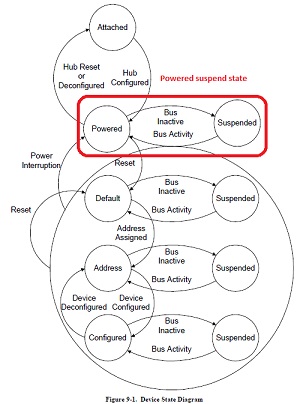Power consumption
USB 2.0
Specification, Section 7.1.2 & 7.1.5
USB 3.0 Specification, Section 9.2.5.1
ECN USB 2.0 Connect Timing Update
In
order to measure
the power distribution of a USB device, the average
current is measured during unconfigured, configured, active
and suspend state with a digital multimeter and fixture
to measure the Vbus current . The circumstances for measuring
the average current are dependent on the speed of the device and the
power mode the device is in (e.g. self powered, bus powered or battery
charging capabilities). All High Speed measurements are performed by
connecting the device under test after one self-powered High Speed hub.
A Full Speed self-powered hub is connected to the first High Speed hub
in order to force a High Speed device under test to enter its Full
Speed mode. Beware that according to USB 2.0 Spec Vbus should stay
between 4.4V and 5.5V, make sure you measure it in worst case
condition.
Speed
conditions
For a High Speed
device the average current is measured in High Speed and Full Speed
mode. For a Full Speed device the average current is measured in Full
Speed mode. For a Low Speed device the average current is measured in
Low Speed mode. A Super Speed device is measured in Super
Speed and High Speed mode.
Power
conditions
A device should also
be measured using the supported power mode in the following
circumstances:
1) When a device is only capable of operating in self-powered
mode, all measurements are per formed in self-powered mode.
This means that the device is unable to enumerate without being
connected to an external power.
2) When a device is capable in operating in bus-powered mode,
all measurements are performed in bus powered mode even when the device
claims to be self-powered (in its device descriptor).
3) When a device has battery-charging capabilities over
USB, the power measurements are performed in worst case
scenario, most probably this is when the product has a dead
battery.
Unconfigured
current
The
USB 2.0 device under test is set in unconfigured state by using the
tool USB20CV. The
USB 2.0 unconfigured current must remain below 100mA at all times. For
a USB 3.0 device the unconfigured state can be force by using USB30CV. A
USB 3.0 device may consume 150mA in unconfigures state. The
unconfigured current is measured in the above conditions.
Configured
current
The device under test is set
in configured state by using the tool for USB2.0 USB20CV and
for USB3.0 USB30CV. In this state the
configured current is measured in the above conditions. The configured
current must remain below the value defined in the bMaxPower field of
the descriptor and may never exceed the maximum allowed 500mA for a USB
2.0 device and 900mA for a USB 3.0 device. However there are devices
that may consume more than the 500mA or 900mA when following the
battery charging specifications.
Active current (U0)
The device under
test is operating correctly and during operation, the device current is
measured using the above conditions. The active current must remain
below the value defined in the bMaxPower field of the descriptor. Make
sure that the current is measured in worst-case power consumption mode.
For USB 3.0 Super speed this is U0 mode.
Suspend
current (U3)
After the device under test is correctly
enumerated the host system is placed in Suspend S3 Mode. When the
device supports remote wakeup, the remote wakeup feature must be
enabled during measurement. The USB 2.0 spec allows a maximum suspend
current of 2.5mA. In general the suspend current is the most difficult
requirement to meet. For USB 3.0 Super Speed this state is called U3.
Note that bus powered compound device (internal USB hub with embedded
devices) may consume 2.5mA for the internal hub plus 2.5mA for each
compounded device. (maximum 4 ports = 12.5mA)
Dead
Battery current
If the USB device have battery charging capabilities the device must
undergo the current measurements with dead battery. Beware
with the ECN USB 2.0 Connect Timing Update taken into account it's
allowed for battery charging devices to consume up to 500mA and not
100mA as mentioned. All battery powered devices must undergo this dead
battery test, it not matter if the product is according to the Battery
Charging 1.2 Specification or not. Device that not charge
batteries may only consume 2.5mA as defined in the next topic Suspend
current Powered state.
Suspend
current Powered state
This measurment is
not the regular suspend current measurement as described above.Do not forget this
measurement!
Peripherals
are required to support the suspend state whenever VBus is powered,
even if bus reset has not occurred. For this test you just need a
A-meter a high speed hub and USB20CV.
After doing the power measurements in USBCV -
unconfigured and configured state- do not switch off USBCV just deatch
and reattach the device and measure the current. The current should
stay below 2.5mA and below 100mA for devices that do battery charging
over USB. Here more details
USB
3.0 Super Speed U1/U2
low power state
Beside U0 and U3 for super speed that are explained above,
the USB 3.0 specification also defines two other low power states U1
and U2.
With USB30CV
you
are able to force the device into U1/U2/U3 power states. The
power
consumption for U1 should be lower than U0 and U2 should be lower than
U1. The
USB 3.0 specification not mentions a value on how much lower the
current should
be.

